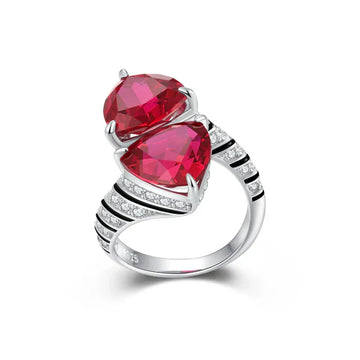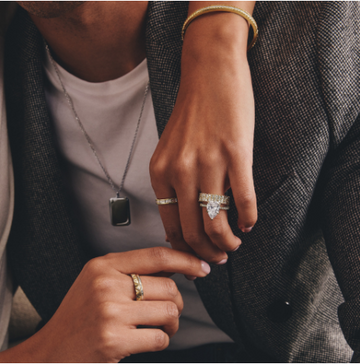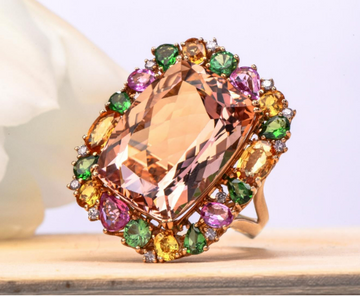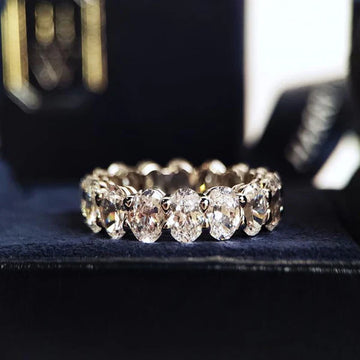The allure of rubies has captivated humanity for centuries. Their vibrant, fiery hue, ranging from a delicate rose to a deep, blood-red, has made them prized gemstones, often associated with passion, power, and enduring love. This ring, with its striking design featuring two prominent ruby gemstones, is a testament to the ruby’s enduring appeal. Let’s delve into the science, symbolism, and style of this captivating piece.
I. The Science of Crimson: Understanding Ruby’s Color
Rubies, like sapphires, are a variety of the mineral corundum (Aluminum oxide, Al₂O₃). Their captivating red color is primarily due to the presence of chromium (Cr) within the crystal lattice.
- Chromium’s Role: Chromium atoms selectively absorb specific wavelengths of light, allowing the red wavelengths to be reflected, which is what gives the ruby its distinctive color. The intensity of the red depends on the concentration of chromium and the presence of other trace elements.
- The “Pigeon’s Blood” Standard: The most desirable rubies possess a vivid, slightly purplish-red color, often referred to as “pigeon’s blood.” This color is highly prized and considered to be the standard for top-quality rubies.
- Birefringence and Pleochroism: Rubies, being a uniaxial crystal, exhibit birefringence, meaning they split light into two rays that travel at different speeds. They can also exhibit pleochroism, meaning the gemstone appears to have different colors when viewed from different angles.
II. The Symbolism and History of Rubies:
Rubies have a rich history, imbued with potent symbolism across various cultures:
- Ancient Beliefs: In ancient India, rubies were associated with the sun and believed to possess the power of life and vitality. Warriors wore them for protection in battle, and they were believed to bring luck and prosperity.
- Love and Passion: Rubies have long been associated with love, passion, and commitment. They are often given as gifts to symbolize deep affection and enduring relationships.
- Royalty and Power: Rubies were highly prized by royalty and nobility throughout history. They were used to adorn crowns, scepters, and other symbols of power and status. The “Black Prince’s Ruby,” housed in the British Crown Jewels, is a prominent example (although it is, in fact, a large red spinel).
- The Four C’s (and Beyond): When evaluating rubies, the “Four C’s” (Carat, Cut, Clarity, and Color) are used to assess their quality. The presence of inclusions (internal imperfections) is often accepted in rubies, as they are a natural characteristic.
III. Analyzing the Ring’s Design:
This ring is a statement piece, showcasing the rubies in a bold and contemporary style:
- Gemstone Arrangement: The ring features two prominently displayed rubies. One appears to be an oval cut, while the other is a modified heart or triangular cut. This unique arrangement adds visual interest and a sense of dynamism to the design. The positioning of the stones creates a dynamic visual flow and suggests a sense of movement.
- The Setting: The gemstones are likely set in a white metal (silver or white gold, potentially rhodium plated), which provides a clean backdrop for the rubies, enhancing their fiery red. The prong setting allows maximum light to enter the stones, maximizing their brilliance.
- Accents and Detail: The band’s intricate design adds further visual interest. The alternating black enamel and clear gemstone details (likely Cubic Zirconia or diamonds) provide a striking contrast and modern touch to the piece, which would also add durability to the design.
- Overall Style: The ring’s design balances classic gemstone beauty with contemporary flair. It’s a piece that is sure to turn heads and spark conversation.
IV. Style and Pairing:
This ring is designed to make a statement. Here are some styling suggestions:
- Occasion: Perfect for formal events, special occasions, or adding a touch of glamour to a night out.
- Pairing: Best paired with neutral-colored clothing (black, white, cream) to allow the ring’s vibrant color to be the focal point. Consider a simple cocktail dress or a classic pantsuit.
- Complementary Jewelry: Keep other jewelry minimal. A simple bracelet or stud earrings can complete the look without overpowering the ring.
V. Sourcing and Ethical Considerations:
- Ruby Origins: Rubies are mined in various locations, including Myanmar (Burma), Thailand, Mozambique, and Madagascar.
- Ethical Sourcing: When purchasing rubies, look for suppliers who are committed to ethical sourcing practices, ensuring fair labor conditions and environmental responsibility.
- Lab-Created Rubies: Lab-created rubies offer a more affordable and ethically conscious alternative, with virtually the same chemical and physical properties as natural rubies.
This ring is a celebration of rubies, the red gemstone that embodies passion and enduring beauty. With its striking design, combined with the symbolism of this precious stone, this is an investment in a timeless piece that will be cherished for years to come.







